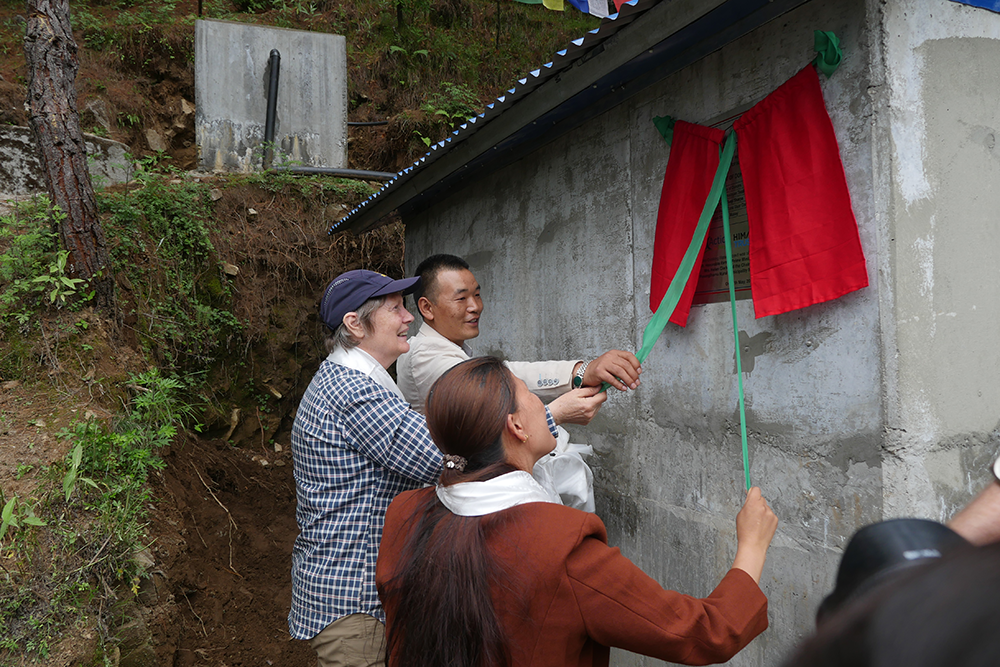An unforgettable experience
By Helen Clark
This year was special. In July, we marked 100 years since Ed’s birth. In this centenary year, I was privileged as Patron of the Himalayan Trust to visit the Solukhumbu District of Nepal. I trekked for 11 days in Ed’s footsteps, through the areas where Ed and the Himalayan Trust have been working since the 1960s.
Trekking up the valley was incredible. We walked up and down steep hillsides, along precipitous traverses, across huge swing bridges, surrounded by snow-capped 8000m peaks. We passed villages clinging to hillsides, but where we would always find a tea house offering warm tea and an even warmer welcome.
Left: Arriving in Khumjung where Ed built the first school in 1961. Right: Reading with young students at Khumjung school.
When Ed first started visiting this region in the 1950s and 60s, for all its stunning natural beauty, what struck him most was just how tough everyday life was for the hard-working and generous people who had become his friends.
When Ed first spoke with the Sherpa communities about what they needed to improve their lives, they immediately said education. In response, Ed built the first school in the region in the village of Khumjung in 1961.
In his work, Ed responded to the needs the communities identified for themselves. As well as access to education, they highlighted a need for health services, and drinkable water.
Wherever I went in the region, the impact of the long-term support from Ed and the Himalayan Trust was obvious in the stories we heard from the people whose lives they have touched. At the schools, clinics, and lodges along the trails, I met countless students of the Hillary schools, including those who had benefitted from scholarships to progress to further education and training.
Take Dr Kami Temba. Dr Kami went to a school built by the Himalayan Trust in the village of Thame. After Grade Four, he had to walk from Thame to the school in Khumjung each day – several hours each way. He was then supported by the Himalayan Trust to complete his high school education and qualify as a community medical assistant, serving in that capacity for 19 years at Khunde Hospital. Recognising his potential, funders supported him to attend the Fiji Medical School to train and qualify as a doctor. In 2002, he took over the management of the hospital. Dr Kami’s story is one of accepting every opportunity offered for education and of dedicating his talent and skill to his community.

With Dr Kami Temba
In the 1970s, Ed and his wife Louise threw their weight behind the creation of the Sagarmatha National Park in the Everest Region – Sagarmatha being the local name for Everest. This was visionary. It helped ensure that the natural environment of the region could be protected, while also providing for the needs of the communities living within the National Park.
The New Zealand Government provided support with training and advice on park management and sustainable forestry. Now, the Sagarmatha National Park is a UNESCO World Heritage Site that encompasses 1,148km2 of land in the Himalayas.
Tourism is the major economic activity in the region, providing work for climbing and trekking guides, and work in the lodges, guest houses and tea houses that can be found in every village along the trails. The tiny air strip in Lukla, built by Ed and the Himalayan Trust in the 1960s to transport construction materials for the hospitals and schools, is now one of the busiest airports in Nepal.
Climbing tourism has also brought great tragedy to Sherpa communities. Around one third of those who have died climbing Everest were Sherpas. This takes a heavy toll on families and communities. I met Ang Dawa, the community medical assistant at the clinic in Phortse village – her father and her brother were both killed on Everest. She has a young child and insists that her husband sticks to working as a trekking guide, which has a fraction of the hazards of being a climbing guide.
Yet, the early investment in education and health by Ed and those who supported him in New Zealand, have enabled the local communities to participate as major stakeholders in the tourism sector and benefit from it. It has given people choices and options.
Despite the positive impact of the work of the Himalayan Trust and their partners, there remains much to do. Access to secondary schooling in the region is limited and ensuring access to safe water continues to be a challenge.
Left: Opening new classroom blocks at Chaurikharka, built to replace those destroyed in the 2015 earthquakes. Right: Opening the new Musey water system, funded by Himalayan Trust supporters.
In the south of the region far below the main trails to Everest where there is less opportunity for tourism-related activity, people are poorer. Indicators like that for maternal mortality are worse.
Even today, not all children in Nepal are in school. Without Ed, one wonders how long it might have taken for the first education and health services to be established in the remote, mountain valleys of Nepal.
It’s an unforgettable experience to come to this region of Nepal and walk in Sir Edmund Hillary’s footsteps. When I think of Ed, I think of greatness. He did amazing things. But he was always humble about his achievements.
To me, that sums up Ed. He never talked about himself. Instead, he talked about what he could for others. It is that sense of service, contribution and giving back to others that I think is a true sign of greatness.
Helen Clark





